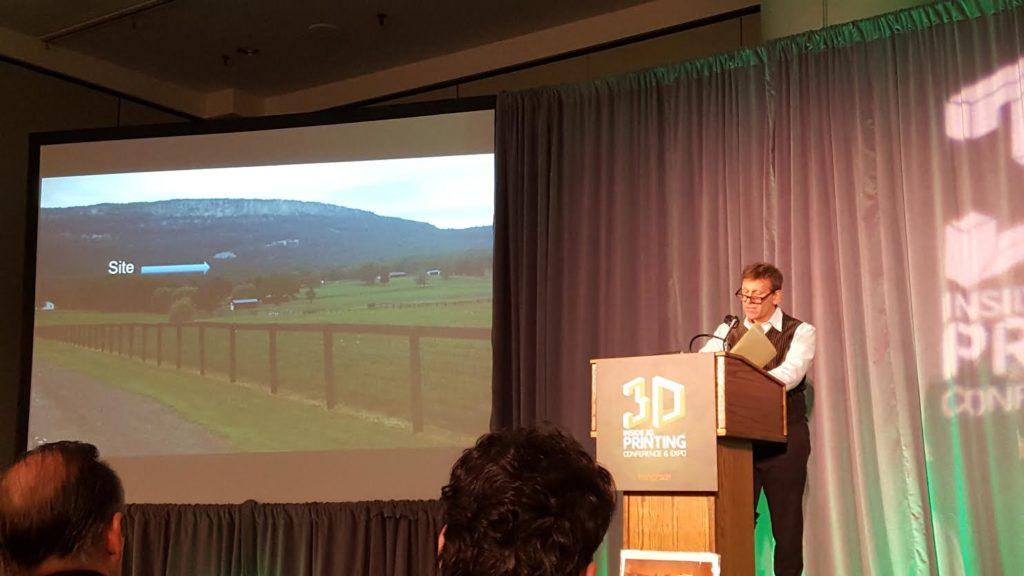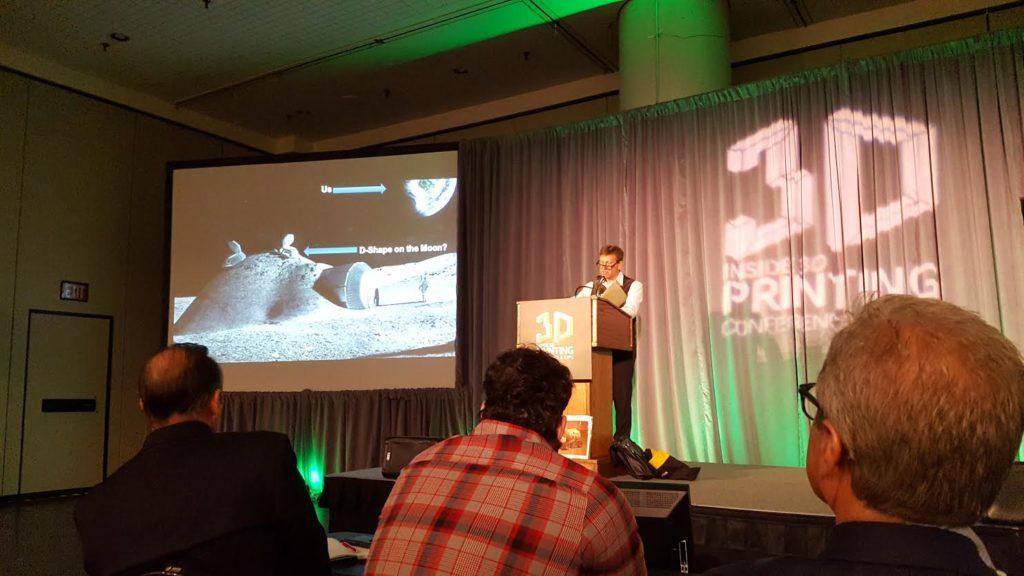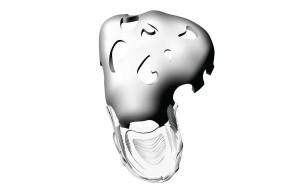![]() One of my great passions is my love of architecture. My father had his own architectural practice for nearly 40 years and my grandfather had his own architectural firm, too. You could say that architecture is in the blood. My father took me to his shopping center, supermarket and office building projects while they were under construction, when I was just a small child. I practically grew up on job sites. So, while D-Shape Enterprise’s talk at Inside 3D Printing New York on 3D printing mega structures was undoubtedly of interest to the many attendees in the audience, I found it absolutely riveting. If D-Shape’s work is any indication of the current state of 3D printed construction and the direction it’s going, then we are in exciting times, indeed.
One of my great passions is my love of architecture. My father had his own architectural practice for nearly 40 years and my grandfather had his own architectural firm, too. You could say that architecture is in the blood. My father took me to his shopping center, supermarket and office building projects while they were under construction, when I was just a small child. I practically grew up on job sites. So, while D-Shape Enterprise’s talk at Inside 3D Printing New York on 3D printing mega structures was undoubtedly of interest to the many attendees in the audience, I found it absolutely riveting. If D-Shape’s work is any indication of the current state of 3D printed construction and the direction it’s going, then we are in exciting times, indeed.
 Adam Kushner, Founding Principal, KUSHNER Studios / D-Shape Enterprises, is a firm believer in under-promising and over-delivering. He said that he first became aware of the possibilities of 3D printed construction when he heard about 3D Print Canal House by DUS Architects, which whet his appetite to get involved in using 3D printing for his architectural projects. Early in 2013, Kushner searched online to see who was involved in full-scale 3D, and only came back with 5 names. It seemed to be a comprehensive list that notably included DUS Architects, Contour Crafting (Khoshnevis), and Enrico Dini with his D-Shape printer. Kushner reached out to all of them, but only Dini got back to Kushner. In June 2014 Kushner traveled to Pisa, Italy to tour Dini’s facilities. He drove to ouskirts of Venice to see the first machine. We’ve been following D-Shape’s work for quite some time.
Adam Kushner, Founding Principal, KUSHNER Studios / D-Shape Enterprises, is a firm believer in under-promising and over-delivering. He said that he first became aware of the possibilities of 3D printed construction when he heard about 3D Print Canal House by DUS Architects, which whet his appetite to get involved in using 3D printing for his architectural projects. Early in 2013, Kushner searched online to see who was involved in full-scale 3D, and only came back with 5 names. It seemed to be a comprehensive list that notably included DUS Architects, Contour Crafting (Khoshnevis), and Enrico Dini with his D-Shape printer. Kushner reached out to all of them, but only Dini got back to Kushner. In June 2014 Kushner traveled to Pisa, Italy to tour Dini’s facilities. He drove to ouskirts of Venice to see the first machine. We’ve been following D-Shape’s work for quite some time.
Kushner and his wife bought a 5-acre property in Upstate New York about a year before thinking of 3D printing on it. As previously reported, the site is less a formal house and more of an R&D study for KUSHNER Studios and D-Shape Enterprises in developing techniques for constructing future projects. The sprawling residence will be composed of a 2400-square-foot house, an impressively large swimming pool, pool house and detached car port, all of which will be 3D printed. The project will use on-site rocks as aggregate material for 3D printing. The ISRU (In-situ Resource Utilization System) for construction is totally green. There’s no off-gassing of VOCs (volitile organic compounds), the 3D printing materials are totally inert (sand, salt water, and magnesium).
- 765 North Mountain Road Pool and Canopies (Pavilion)
- Renders of the construction
- Site plans
- Pool elevation
The seasonal tree canopies gracing the site served as a basis for the design. The pool was inspired by rock structures on the property. There are no building codes for 3D printing buildings. Kushner literally had to write his own ‘3D printing’ tick box on the permit application, rather than check ‘stick built’ or the other two options listed. While it took some convincing the local municipality, they ultimately approved the project and permits were issued with some speed. As far as Kushner is aware, this is the first known 3D printed building project to be approved in the US. KUSHNER Studios was recently selected as a finalist in the Architizer architectural awards for the 3D printed house concept, formally known as the 765 North Mountain Road Pool and Canopies Pavilion, which has garnered them a lot of interest (UPDATE: the project was a winner of the Architizer Award Plus Category: Architecture +3D Printing).
As Kushner explains, “What we are finding out is that there is an incredible desire to see this technology come to fruition and we’re prepared to finally say, that yes the future is now.”
 According to Kushner trees were cleared to make a road and it took some time just to get power to the remote site. They began excavations last September to put footings in for the construction and further work had to be postponed when the upstate winter set in. Construction is set to resume within the next few weeks. Meanwhile, the firm is making some tweaks to their plans and models.
According to Kushner trees were cleared to make a road and it took some time just to get power to the remote site. They began excavations last September to put footings in for the construction and further work had to be postponed when the upstate winter set in. Construction is set to resume within the next few weeks. Meanwhile, the firm is making some tweaks to their plans and models.
This time last year, KUSHNER was preparing samples and tests for the project and was fully expecting the arrival of the D-Shape printer. The printer was designed by Enrico Dini for a private Spanish company and is a monster of a machine, nearly 2 stories high. KUSHNER recently completed construction of a bunker for the Italian military, built with the D-Shape printer, but getting the printer to the US was fraught with problems. When the enormous 3D printer was set to return to the US, it was at first declared to be a WMD (weapon of mass destruction) by the Italian military and KUSHNER had to spend the better part of the year convincing them that this was in fact not the case.
Even after the confusion was cleared up the military wasn’t willing to release the printer, but instead wanted to lease it to KUSHNER. Apparently, the printer was finally released when someone from Amazon requested it for a secret tech conference called MARS (Machine-Learning Automation, Robotics & Space Exploration) that was held in the desert of Palm Springs, CA, in March. Attendees included representatives from Rethink Robotics, Toyota and academics from MIT, the University of California at Berkeley and ETH Zurich. The D-Shape was sent to the conference via air shipment at the cost of about $70K. Though KUSHNER was able to 3D print some interesting coffee table-sized objects with the printer, the real benefit was that it was being reviewed by Amazon founder and CEO Jeff Bezos, film director Ron Howard and industry leaders and was seen as being an important technology of our future technology on par with drones and self-driving cars.
Adam Kushner says that KUSHNER Studios is technology agnostic and is willing to work with other innovators in the field of 3D printed construction…
“We can dispense with the silly Mac vs. PC arguments,” says Kushner. “What we will do is not necessarily promote the D-Shape technology, but rather since our forte is architecture and construction, we want to be the go-to company for construction-scale 3D printing. Our sand deposition system will not make sense for all projects, so we’ve been in touch with everyone in the industry, WinSun, Khoshnevis, Rudenko, and even those that do not yet loom large, we feel have something to offer the field. One of the great misnomers in this field is this idea that 3D printing for the construction industry is the matter of getting machinery into the hands of the public, this is simply isn’t the case.”
 Kushner went on to explain that there are a few disciplines that go into 3D printed construction and without a thorough grasp of each one and how they are interrelated, you will not have a successful project. Chief among those disciplines is materials research. What materials you use is as important as how you use it. Where is the project going to be constructed? As Kushner explains:
Kushner went on to explain that there are a few disciplines that go into 3D printed construction and without a thorough grasp of each one and how they are interrelated, you will not have a successful project. Chief among those disciplines is materials research. What materials you use is as important as how you use it. Where is the project going to be constructed? As Kushner explains:
“Will it be underwater? Will it be in the brutal Northeast climates or the rather hot and humid environments of Northern Italy and Florida? Will it be used to make a one-story villa or 3-story apartment building? These are all essential questions that have to be figured out and answered and the materials need to be carefully tailored for each condition.”
Answering those questions is just the first step. Next you have to decide who’s going to run the 3D printer, who’s your workforce? And then there’s the 3D modeling. It’s not just about designing overhangs so that they are printable, but how do you get doorways and lintels in? How do you get different printed pieces to fit together, how do you deal with site logistics? Where will the stresses and strains occur and who will perform the finite element analysis? Actually, Kushner says, that they developed their own proprietary software that was designed for that last piece. It seems that Kushner is well aware of the specific challenges facing 3D printed buildings. Kushner went on to talk about compliance:
“Who certifies all this to being safe? This is a brave new world and there are few precedents. We got our pool project approved and permitted because it’s fairly common in the industry for architects to self-certify projects, especially in rural or suburban locations. There’s no UL testing, there’s no MEA numbers and very little analytics. We have performed load testing and we do know that our PSI strengths… they range from about 900 – 1450 PSI, but it’s long way before my numbers are accepted by any municipality. And so 3D printing cannot be done in any dense urban area for anything other than non-lead bearing applications”
 Kushner contends that his company is the only one that is working on addressing all these issues, that of compliance, 3D printing technology, materials research, labor and software development. One of the limitations that Kushner see is that lack of reinforced concrete as a method of 3D printed construction. He believes that until this is developed the industry is only living up to half of its potential. So how do you create a reinforced 3D printed concrete? D-Shape has partnered with Owens Corning and are currently testing new fiberglass insertions as a substitute for steel rebar.
Kushner contends that his company is the only one that is working on addressing all these issues, that of compliance, 3D printing technology, materials research, labor and software development. One of the limitations that Kushner see is that lack of reinforced concrete as a method of 3D printed construction. He believes that until this is developed the industry is only living up to half of its potential. So how do you create a reinforced 3D printed concrete? D-Shape has partnered with Owens Corning and are currently testing new fiberglass insertions as a substitute for steel rebar.
While creating a reinforced concrete is a necessary step towards strengthening 3D printed structures there is still the thorny issue of how to print horizontal structures. There are some solutions that have been suggested, including using pneumatic supports, but KUSHNER has a different approach.
“Our current system that builds in the solid can handle this, but admittedly it’s not he most elegant solution, as once we cast we have to vacuum away all the sand,” says Kushner.
Their work with a private Spanish company was their first attempt to create a machine that can self-evacuate the supporting sand using a stepped system that can trundle the sand back up to the top of the machine for reuse.
The D-Shape printer is one of the largest construction printers in the world and Adam Kushner contends that it can print up to 20 feet cubed. But KUSHNER wants to build bigger and to that end they are working on a system that can be added to infinitely, a railed system that is not limited in the X and Y directions and is site-specific. The final problem faced by 3D printed construction, as Kushner sees it, is site specificity and flexibility. Current systems are limited to printing on easily accessible, flat cleared sites. He referenced WinSun’s approach of printing on flat surfaces and then moving the pieces to their final location, and noted that this is highly ineffective. Kushner finds Gensler’s 3D printing concrete using drones too be a novel idea, but impractical as it would be difficult to achieve the tolerances necessary for construction. Kushner mentioned that his company is talks with Caterpillar to develop better solutions to this issue. Despite all the issues facing 3D printed construction, Kushner is enthusiastic about the possibilities and sees a bright future:
“Personally, I see amazing things coming out of this and it’s my hope, in a small way, that our contributions will add something to a healthier, smarter and more resourceful future for all of us. And if this technology accomplishes this, and if D-Shape is somewhere on the frontline of this phenomenon, we will all be quite satisfied with that. We have learned that 3D printing for the construction industry is definitely here and we are on the cusp of getting it started and I’m confident that this is for real.”
Do you think 3D printing will truly find a place in the world of architecture–and home construction? Discuss in the Kushner Discusses 3D Printed Architecture forum over at 3DPB.com.
 [Images from Inside 3D Printing NYC taken on-site during Kushner’s talk by Sarah Goehrke for 3DPrint.com; images collected of design plans belong to Kushner/D-Shape]
[Images from Inside 3D Printing NYC taken on-site during Kushner’s talk by Sarah Goehrke for 3DPrint.com; images collected of design plans belong to Kushner/D-Shape]
Subscribe to Our Email Newsletter
Stay up-to-date on all the latest news from the 3D printing industry and receive information and offers from third party vendors.
Print Services
Upload your 3D Models and get them printed quickly and efficiently.
You May Also Like
Reinventing Reindustrialization: Why NAVWAR Project Manager Spencer Koroly Invented a Made-in-America 3D Printer
It has become virtually impossible to regularly follow additive manufacturing (AM) industry news and not stumble across the term “defense industrial base” (DIB), a concept encompassing all the many diverse...
Inside The Barnes Global Advisors’ Vision for a Stronger AM Ecosystem
As additive manufacturing (AM) continues to revolutionize the industrial landscape, Pittsburgh-based consultancy The Barnes Global Advisors (TBGA) is helping shape what that future looks like. As the largest independent AM...
Ruggedized: How USMC Innovation Officer Matt Pine Navigates 3D Printing in the Military
Disclaimer: Matt Pine’s views are not the views of the Department of Defense nor the U.S. Marine Corps Throughout this decade thus far, the military’s adoption of additive manufacturing (AM)...
U.S. Congress Calls Out 3D Printing in Proposal for Commercial Reserve Manufacturing Network
Last week, the U.S. House of Representatives’ Appropriations Committee moved the FY 2026 defense bill forward to the House floor. Included in the legislation is a $131 million proposal for...









































